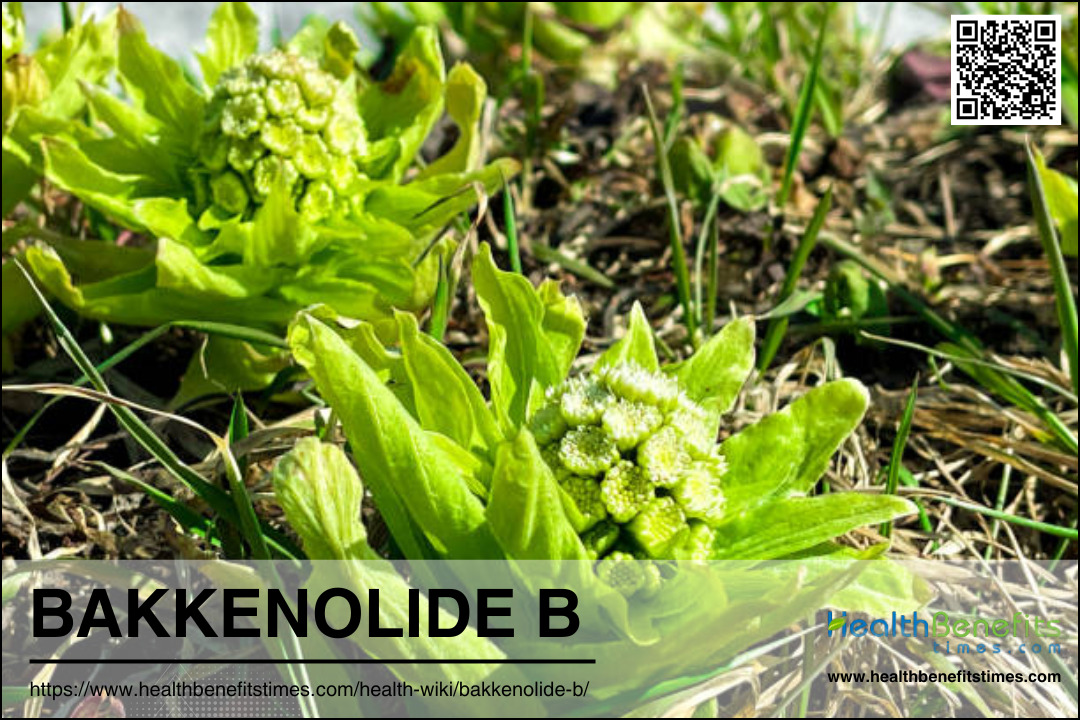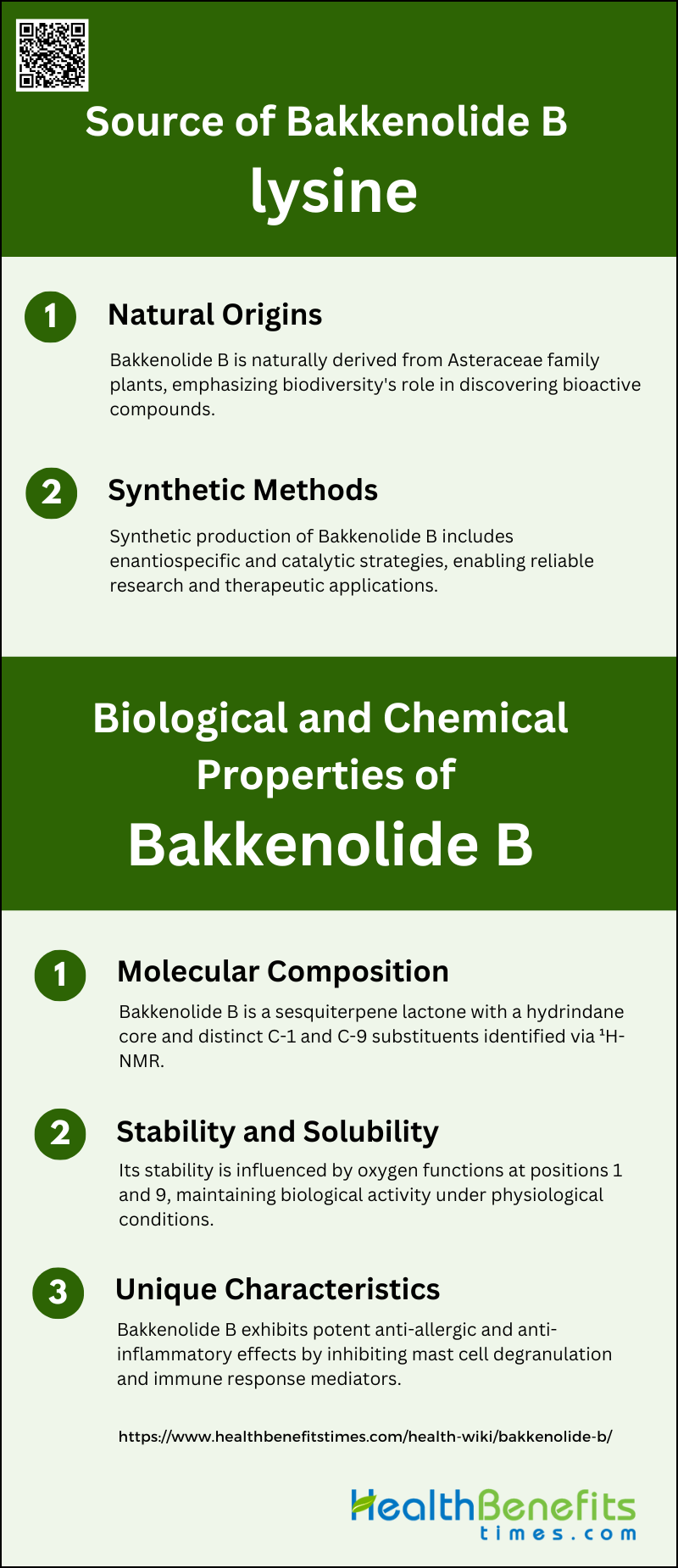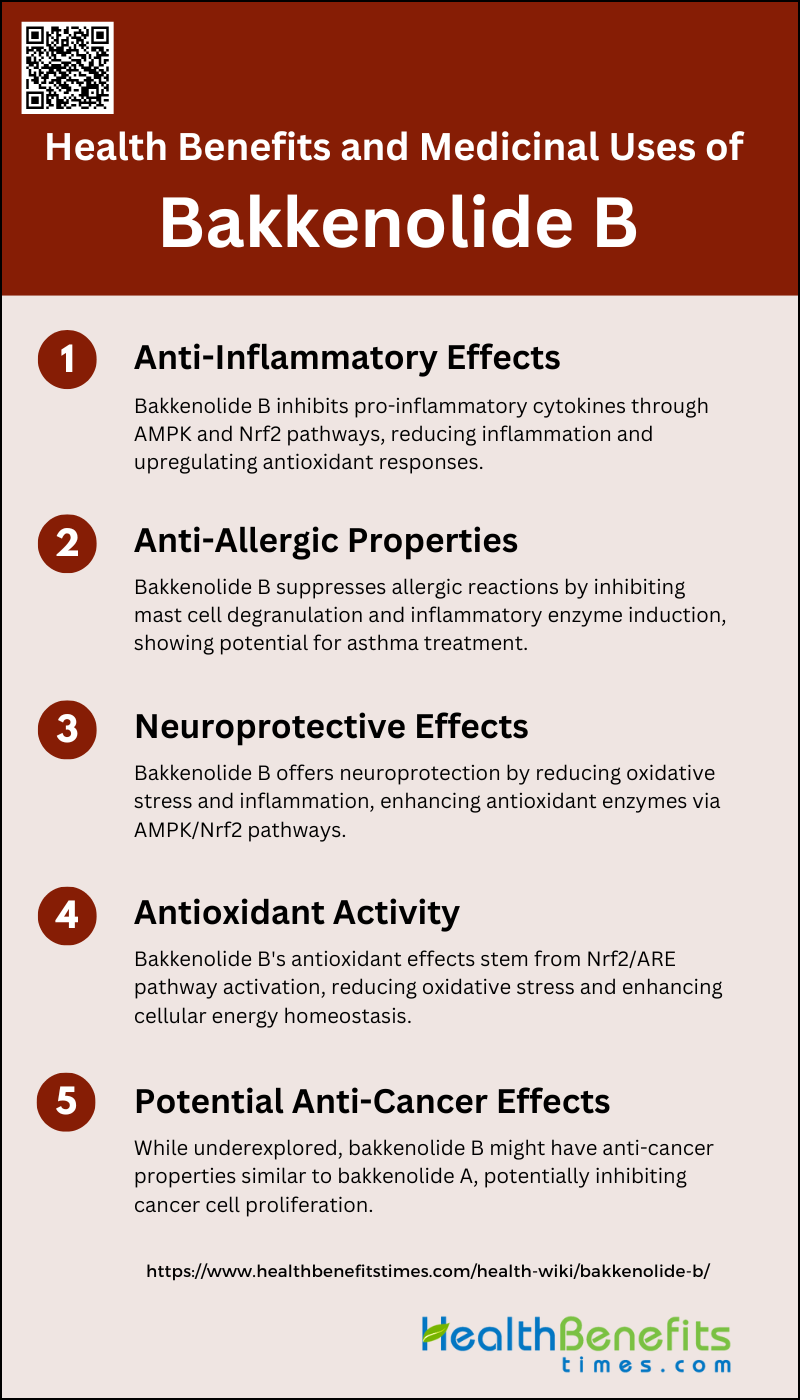 Bakkenolide B is a bioactive compound isolated from the leaves of Petasites japonicus, a plant known for its medicinal properties. This compound has demonstrated significant anti-allergic and anti-inflammatory effects. Research has shown that Bakkenolide B can inhibit mast cell degranulation and the induction of inflammatory enzymes such as inducible nitric oxide synthase and cyclooxygenase 2, making it a potential treatment for asthma and other allergic conditions. Bakkenolide B has been found to reduce the production of pro-inflammatory cytokines in microglia, suggesting its potential in treating neuroinflammatory conditions like Alzheimer’s and Parkinson’s diseases by activating the AMPK/Nrf2 signaling pathway. Furthermore, it has been identified as an inhibitor of interleukin-2 production in human T cells, indicating its role in modulating immune responses. The compound’s structure and its seasonal variation in Petasites japonicus have been well-documented, providing a basis for its quality control and extraction optimization. Overall, Bakkenolide B holds promise as a therapeutic agent due to its diverse biological activities.
Bakkenolide B is a bioactive compound isolated from the leaves of Petasites japonicus, a plant known for its medicinal properties. This compound has demonstrated significant anti-allergic and anti-inflammatory effects. Research has shown that Bakkenolide B can inhibit mast cell degranulation and the induction of inflammatory enzymes such as inducible nitric oxide synthase and cyclooxygenase 2, making it a potential treatment for asthma and other allergic conditions. Bakkenolide B has been found to reduce the production of pro-inflammatory cytokines in microglia, suggesting its potential in treating neuroinflammatory conditions like Alzheimer’s and Parkinson’s diseases by activating the AMPK/Nrf2 signaling pathway. Furthermore, it has been identified as an inhibitor of interleukin-2 production in human T cells, indicating its role in modulating immune responses. The compound’s structure and its seasonal variation in Petasites japonicus have been well-documented, providing a basis for its quality control and extraction optimization. Overall, Bakkenolide B holds promise as a therapeutic agent due to its diverse biological activities.
History and Discovery of Bakkenolide B
The history and discovery of Bakkenolide B are rooted in the exploration of natural compounds from various plant species. Initially, bakkenolides were isolated from the roots of Petasites formosanus, where thirty-two new bakkenolides, including bakkenolide B, were identified and characterized through spectral analysis. A significant milestone in the study of bakkenolide B was its identification as an inhibitor of interleukin-2 production in human T cells, discovered using a yeast-based screening method from the flower buds of Petasites japonicus. Additionally, bakkenolide B, along with other analogues, was isolated from the roots of Valeriana jatamansi, where it exhibited potent neuroprotective effects against neuronal cell death. These discoveries highlight the diverse biological activities and potential therapeutic applications of bakkenolide B, marking important steps in its research and development.
Source of Bakkenolide B
Bakkenolide B, a sesquiterpene lactone, is derived from both natural and synthetic sources. Understanding these sources is crucial for its effective utilization in various applications. Below are the primary sources of Bakkenolide B:
1. Natural Origins
Bakkenolide B, a member of the bakkenolide family, is naturally derived from various plant sources. These compounds are typically found in the roots and aerial parts of certain species within the Asteraceae family. The natural extraction of bakkenolides involves isolating these compounds from plant material using solvent extraction and chromatographic techniques. The biological activities of bakkenolides, including anti-inflammatory and anticancer properties, have made them a subject of interest in natural product research. Their natural occurrence underscores the importance of biodiversity in discovering bioactive compounds.
2. Synthetic Methods
The synthetic methods for producing Bakkenolide B have seen significant advancements. One notable approach involves the enantiospecific synthesis starting from (S)-(+)-carvone, where a radical cyclization of an iodoketone intermediate forms the cis-hydrindanone skeleton, leading to the production of bakkenolide B through further transformations. Another method employs a catalytic enantioselective strategy using N-heterocyclic carbene-catalyzed desymmetrization of a 1,3-diketone, which efficiently constructs the hydrindane core of bakkenolides with high enantio- and diastereoselectivity. These synthetic routes provide a reliable means to produce bakkenolide B for research and potential therapeutic applications.
Biological and Chemical Properties of Bakkenolide B
Bakkenolide B is a naturally occurring sesquiterpene lactone with significant biological activities. This compound has garnered attention due to its unique molecular composition, stability, solubility, and distinctive characteristics. Below is a detailed examination of its properties:
1. Molecular Composition
Bakkenolide B is a sesquiterpene lactone isolated from the leaves of Petasites japonicus. The molecular structure of bakkenolide B includes a hydrindane core, which is a common feature among bakkenolides. This core structure is formed through a key bond-forming step involving an N-heterocyclic carbene-catalyzed desymmetrization of a 1,3-diketone, resulting in high enantio- and diastereoselectivity. The molecular composition is further characterized by the presence of specific substituents at the C-1 and C-9 positions, which can be identified through spectral analysis, including 1H-NMR.
2. Stability and Solubility
The stability and solubility of bakkenolide B are influenced by its chemical structure, particularly the presence of oxygen functions at the 1 and 9 positions. These functional groups participate in fragmentation patterns, as observed in mass spectrometry studies. Bakkenolide B’s solubility in various solvents has not been explicitly detailed in the provided data, but its stability in biological systems is suggested by its ability to inhibit antigen-induced degranulation in mast cells and gene inductions in macrophages, indicating that it remains active under physiological conditions. Additionally, its inhibitory effects on interleukin-2 production in human T cells further support its stability in cellular environments.
3. Unique Characteristics
Bakkenolide B exhibits several unique biological properties, making it a potent agent for therapeutic applications. It has demonstrated significant anti-allergic and anti-inflammatory effects by inhibiting mast cell degranulation and the induction of inducible nitric oxide synthase and cyclooxygenase 2 in macrophages. Furthermore, it has shown the ability to inhibit interleukin-2 production in human T cells, which is crucial for immune response modulation. These properties highlight bakkenolide B’s potential as a treatment for conditions such as asthma and other inflammatory diseases. Its unique structure-activity relationships, particularly the role of specific substituents, contribute to its distinct biological activities.
Mechanism Action of Bakkenolide B
How Bakkenolide B Works at a Molecular Level
Bakkenolide B, isolated from Petasites japonicus, exhibits significant anti-allergic and anti-inflammatory properties. At the molecular level, it inhibits antigen-induced degranulation in RBL-2H3 mast cells by reducing β-hexosaminidase activity. Additionally, it suppresses the induction of inducible nitric oxide synthase (iNOS) and cyclooxygenase-2 (COX-2) in mouse peritoneal macrophages, which are key enzymes involved in inflammatory responses. This inhibition suggests that bakkenolide B interferes with the signaling pathways that lead to the production of these inflammatory mediators, thereby reducing inflammation and allergic reactions.
Interaction with Cellular Pathways and Receptors
Bakkenolide B interacts with several cellular pathways, notably the calcineurin pathway, which is crucial for T-cell activation and interleukin-2 (IL-2) production. In a yeast-based screening system, bakkenolide B was found to inhibit the calcineurin pathway, leading to reduced IL-2 production in Jurkat cells, a human T-cell line. This inhibition occurs at both the gene and protein levels, although bakkenolide B does not directly inhibit the phosphatase activity of calcineurin. Additionally, bakkenolide B’s ability to inhibit NF-κB activation, a key transcription factor in inflammatory responses, further underscores its role in modulating immune and inflammatory pathways.
Health Benefits and Medicinal Uses of Bakkenolide B
Bakkenolide B, a potent sesquiterpene lactone, has been extensively studied for its therapeutic potential. This compound exhibits a range of health benefits and medicinal uses, making it a valuable subject of research. Below is a detailed exploration of its benefits and applications:
1. Anti-Inflammatory Effects
Bakkenolide B, derived from Petasites japonicus, exhibits significant anti-inflammatory properties. It has been shown to inhibit the production of pro-inflammatory cytokines such as interleukin (IL)-1β, IL-6, IL-12, and tumor necrosis factor (TNF)-α in microglial cells. This inhibition is mediated through the activation of the AMP-activated protein kinase (AMPK) and nuclear factor erythroid 2-related factor 2 (Nrf2) signaling pathways. The activation of these pathways leads to the upregulation of antioxidant response elements, which further suppresses the inflammatory response.
2. Anti-Allergic Properties
Bakkenolide B has demonstrated potent anti-allergic effects. It inhibits antigen-induced degranulation in RBL-2H3 mast cells, which is a critical step in allergic reactions. Additionally, bakkenolide B suppresses the induction of inducible nitric oxide synthase (iNOS) and cyclooxygenase 2 (COX-2) in mouse peritoneal macrophages. In an ovalbumin-induced asthma model, bakkenolide B significantly reduced the accumulation of eosinophils, macrophages, and lymphocytes in bronchoalveolar lavage fluid, indicating its potential as a therapeutic agent for allergic conditions such as asthma.
3. Neuroprotective Effects
Bakkenolide B has shown promising neuroprotective effects, particularly in the context of neuroinflammatory and neurodegenerative diseases. It reduces oxidative stress and neuronal death by inhibiting the production of reactive oxygen species (ROS) and pro-inflammatory cytokines in microglial cells. The compound activates the AMPK/Nrf2 signaling pathway, which enhances the expression of antioxidant enzymes like NADPH dehydrogenase quinone 1 (NQO1) and heme oxygenase 1 (HO1). These actions collectively contribute to the neuroprotective properties of bakkenolide B, making it a potential therapeutic agent for diseases like Alzheimer’s and Parkinson’s.
4. Antioxidant Activity
Bakkenolide B exhibits significant antioxidant activity, which is crucial for its anti-inflammatory and neuroprotective effects. The compound activates the Nrf2/ARE signaling pathway, leading to the upregulation of antioxidant enzymes such as NQO1 and HO1. This activation helps in reducing the levels of ROS, thereby mitigating oxidative stress. The antioxidant properties of bakkenolide B are further supported by its ability to enhance the phosphorylation of AMPK, which plays a vital role in cellular energy homeostasis and oxidative stress response.
5. Potential Anti-Cancer Effects
While specific studies on the anti-cancer effects of bakkenolide B are limited, related compounds like bakkenolide A have shown promising results in cancer research. Bakkenolide A has been found to inhibit leukemia cell proliferation by regulating the HDAC3 and PI3K/Akt signaling pathways. It induces apoptosis and cell death in leukemia cells by downregulating pro-inflammatory cytokines and activating caspases. Given the structural similarities, it is plausible that bakkenolide B may also possess anti-cancer properties, warranting further investigation.
Applications in Medicine and Industry of Bakkenolide B
Medical Uses and Potential Treatments
Bakkenolide B has shown significant potential in medical applications, particularly in treating allergic and inflammatory conditions. Research indicates that Bakkenolide B, isolated from Petasites japonicus leaves, can inhibit mast cell degranulation and reduce the induction of inflammatory enzymes such as inducible nitric oxide synthase and cyclooxygenase 2. In an ovalbumin-induced asthma model, Bakkenolide B effectively reduced the accumulation of eosinophils, macrophages, and lymphocytes in bronchoalveolar lavage fluid, suggesting its potential as a potent agent for asthma treatment. Additionally, Bakkenolide A, a related compound, has demonstrated efficacy in inhibiting leukemia cell proliferation and inducing apoptosis through the regulation of HDAC3 and PI3K/Akt-related signaling pathways.
Industrial Applications
While the primary focus of Bakkenolide B research has been on its medical applications, its industrial uses are less documented. However, the synthesis of Bakkenolide B and related compounds has been explored, which could have implications for the pharmaceutical industry. The enantiospecific total synthesis of Bakkenolide B and other related compounds from (S)-(+)-carvone involves complex chemical processes, including radical cyclization and synthetic transformations. These methods could be utilized in the large-scale production of Bakkenolide B for pharmaceutical applications, potentially reducing costs and improving accessibility.
Emerging Technologies Involving Bakkenolide B
Emerging technologies involving Bakkenolide B are primarily centered around its neuroprotective properties. Studies have shown that total bakkenolides, which include Bakkenolide B, can protect neurons against cerebral ischemic injury by inhibiting nuclear factor-κB (NF-κB) activation. This inhibition is achieved through the suppression of key signaling pathways, including the phosphorylation of IκB-kinase complex and NF-κB/p65. These findings suggest that Bakkenolide B could be developed into new therapeutic agents for treating cerebral ischemic diseases, offering a novel approach to neuroprotection and potentially improving outcomes for patients suffering from stroke and other ischemic conditions.
Safety and Side Effects of Bakkenolide B
Known Safety Profile
Bakkenolide B, a compound isolated from Petasites japonicus leaves, has been studied for its anti-allergic and anti-inflammatory properties. Research indicates that it can inhibit mast cell degranulation and reduce the induction of inflammatory enzymes such as inducible nitric oxide synthase and cyclooxygenase 2 in mouse peritoneal macrophages. Additionally, in an ovalbumin-induced asthma model, bakkenolide B significantly reduced the accumulation of eosinophils, macrophages, and lymphocytes in bronchoalveolar lavage fluid, suggesting a favorable safety profile for its use in treating allergic and inflammatory conditions.
Possible Side Effects and Precautions
While bakkenolide B shows promise as an anti-allergic and anti-inflammatory agent, potential side effects and precautions must be considered. The compound’s ability to inhibit inflammatory responses could potentially suppress normal immune functions, leading to an increased risk of infections. Additionally, the anti-allergic effects observed in animal models, such as reduced sneezing and eosinophil infiltration, suggest that high doses might cause unwanted immunosuppression. Therefore, it is crucial to monitor patients for signs of immunosuppression and adjust dosages accordingly to minimize risks.
Guidelines for Usage
For the therapeutic use of bakkenolide B, it is recommended to start with lower doses and gradually increase based on patient response and tolerance. In animal studies, doses ranging from 5 mg/kg to 40 mg/kg have been used effectively to reduce allergic symptoms and inflammation. It is advisable to conduct thorough patient evaluations before initiating treatment and to monitor for any adverse effects during the course of therapy. Given its potent anti-inflammatory properties, bakkenolide B should be used with caution in patients with compromised immune systems or those on immunosuppressive therapies.
FAQs
1. What are the natural sources other than Petasites japonicus where Bakkenolide B can be found?
The article mentions Petasites japonicus as a primary source but does not explore other plant species or natural sources that may also contain Bakkenolide B or its analogs.
2. Are there any known interactions between Bakkenolide B and other medications or supplements?
The article does not discuss potential interactions between Bakkenolide B and commonly used medications, herbal supplements, or dietary ingredients.
3. What are the recommended dosage guidelines for Bakkenolide B in humans?
While animal studies are referenced, there is no information on the recommended dosages for human use or clinical guidelines for its administration.
4. Is Bakkenolide B available in any commercial products, such as supplements or pharmaceuticals?
The article does not mention whether Bakkenolide B is currently incorporated into any commercial products available to consumers.
5. What are the long-term effects of Bakkenolide B usage?
The article provides information on the biological effects of Bakkenolide B but does not address the potential long-term health effects or risks associated with its prolonged use.
6. How does Bakkenolide B compare to other anti-inflammatory or anti-allergic compounds in terms of efficacy and safety?
There is no comparison of Bakkenolide B with other well-known anti-inflammatory or anti-allergic compounds, which could help in understanding its relative efficacy and safety.
7. Are there ongoing clinical trials investigating Bakkenolide B?
The article does not mention any ongoing or planned clinical trials that may be exploring the therapeutic potential of Bakkenolide B in humans.
8. Can Bakkenolide B be used in combination with other natural compounds for enhanced therapeutic effects?
The potential for combining Bakkenolide B with other natural or synthetic compounds for synergistic effects is not discussed.
9. What are the environmental impacts of sourcing Bakkenolide B from natural plant sources?
The article does not address the environmental implications of harvesting Petasites japonicus or other plants for the extraction of Bakkenolide B, nor does it explore sustainable practices for its production.
10. Is there any evidence of Bakkenolide B’s efficacy in treating conditions beyond allergies, inflammation, and neurodegenerative diseases?
While the article covers its effects on allergies, inflammation, and neurodegenerative conditions, it does not explore potential benefits in other areas, such as cardiovascular health, skin disorders, or metabolic conditions.



